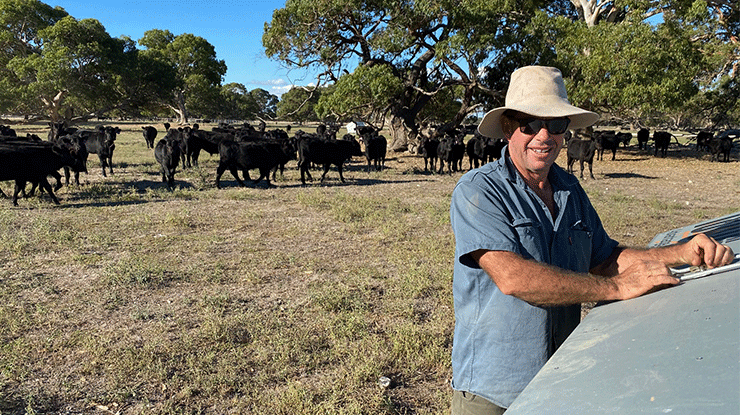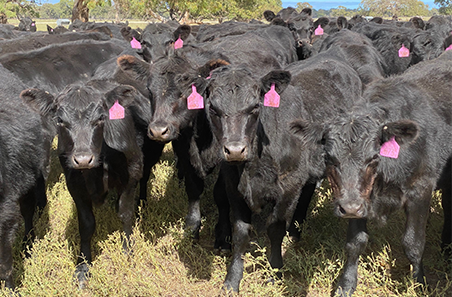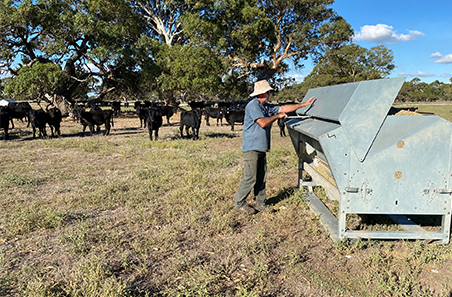Taking a science-based approach to pastures
21 April 2021

With his background in cattle and pasture management research, it’s no surprise SA beef producer Michael Cobiac looks for information based on science.
He’s a strong advocate for programs such as MLA’s More Beef from Pastures, Profitable Grazing Systems (PGS) Pasture Principles and MLA Producer Demonstration Sites (PDS) and has relied on their data-backed guidance to manage pastures since he returned to the family farm, ‘Chelestan’, at Reedy Creek in 2010.
In 2014, Michael and his partner Cath Bell purchased Chelestan. They were running sheep and cattle but three years ago sold the flock and started increasing cattle numbers.
Michael purchased another property, ‘Gumlea’, two years ago, increasing the total grazing area from 600ha to 1,100ha. Over the past four years he’s gone from joining 250 Angus breeders to joining 900.
Cath works off farm and their young children, William and Zoe, are in primary school, leaving Michael as the sole labour unit – a factor which plays into his fine-tuned approach to management.
Production targets
Michael carefully manages pastures to maximise kilograms of beef produced per hectare.
His production targets have evolved as his enterprise mix has changed, and are currently:
- 80% or higher conception rate in a six-week (two cycles) joining
- less than 5% dystocia (difficult birth) rate in heifers
- more than 95% weaning rate from animals born
- 450–500kg liveweight for turn-off in October or November of the year after animals are born.
“These are initial targets, rather than ‘stretch’ targets, because I’ve had quite a change in my production system over the past three years and have been focused on herd expansion,” Michael said.
“When I’m comfortable we’re achieving these targets, I’ll increase my expectations of conception and weaning rate.”
Seasonal challenges
The biggest seasonal challenge each year is managing animal nutrition in autumn and early winter, when paddock feed is least available.
Seasonal variability also throws a curve ball, such as when they receive lower-than-average spring rain – which results in less dry carryover feed for summer and autumn – and above-average winter rain. The farm is flat and can become boggy, leading to low pasture growth, and soil and pasture damage through pugging.
“Seasonal variability in recent years has mostly involved lower winter rainfall and that has generally been beneficial, as we haven’t had those challenging, very wet winters,” Michael said.
Strategic pasture management

Michael’s management program is based on trying to fit all major animal management activities into periods of good pasture growth, and he uses some ‘non-negotiable’ targets to achieve this.
“We join animals in late spring, so the females have good body condition because of good pasture availability,” he said.
“We calve in winter onto green feed – we’re only 20km from the coast and get pasture growth all winter – which provides good nutrition to the cows.
“We sell animals late in their second spring when their weight gains are maximised.
“The challenge is that I wean in autumn, when there is little pasture, so I have to supplementary feed. Usually it’s hay, but this year I’m also providing pellets via a lick feeder.”
His ‘non-negotiables’ are:
Restrict grazing at start of the season: Opening rains start in late April or May, and Michael holds animals in as few small paddocks as possible until there is about 2,000kg dry matter a hectare (DM/ha) across the ungrazed paddocks – usually in June.
Rotational grazing targets: When rotational grazing begins, he moves cattle to the next paddock when pasture drops below about 1,500kg DM/ha.
The whole property is measured monthly, during the growing season, with a plate meter. Grazed paddocks are measured as required, when pasture amount declines towards the minimum desired.
“The key point with rotational grazing is that you must allow pastures to grow to their appropriate stage – for example, third-leaf stage in ryegrass – before you begin grazing,” Michael said.
“Half of the pasture will grow in the last one-third of the rest period. If you only leave it for half, or even two-thirds, of the rest period, you’re just sacrificing so much potential pasture growth.”
Body condition score: Michael targets a body condition score above 2 throughout the year – ideally in a range between 2.5 to 3.5. If this goal can’t be achieved with pasture, he supplementary feeds.
Breeder performance
Michael was profiled in Feedback in 2017 – at the time, his goal was to maximise breeding herd fertility. This focus has intensified with the switch to a pure beef enterprise and emphasis on herd expansion.
“Part of maximising fertility is achieving body condition score targets,” he said.

“I’ve moved from autumn to winter calving to calve down on green feed and re-join in late spring, also on green feed.
“I’ve also introduced larger mobs – 150 cows plus calves – and increased grazing pressure. With the 20% increase in stocking rate I have achieved, more calves are now born due to an increased number of breeders per hectare.”
Bull selection has also been critical, with Michael selecting sires with the genetic ability to produce easier-calving heifers.
“Three main criteria need to be above average: scrotal size, body fat and calving ease,” he said.
“I’ve been purchasing bulls with those features for several years and I’m really starting to notice some differences.
“Calving difficulty in my heifers is down from 10% to less than 5%, which I attribute to changing the timing of calving, and sire selection.”
While he reckons his conception rate of 80% is acceptable for a six-week joining period, especially while his whole production system is evolving, Michael does have his sights set on an eventual target of more than 85%.
A well-stocked toolbox
As well as participating in More Beef from Pastures and PGS Pasture Principles – which he reckons is one of the best courses he’s ever done – Michael is currently participating in a ‘Reproductive health and management techniques for beef heifers’ PDS, run by the University of Adelaide.
He’s also involved in a benchmarking group of producers from south-east South Australia and draws on the expertise of a private advisor who provides an independent, farm advisory board service.
|
Name: Michael Cobiac and Cath Bell Lessons Learned • Rotational grazing provides good feed availability throughout the growing season, but don’t start rotational grazing until you have the infrastructure in place: solid fencing, reliable water points, and yards big enough to handle the mob sizes you’re going to run. |


